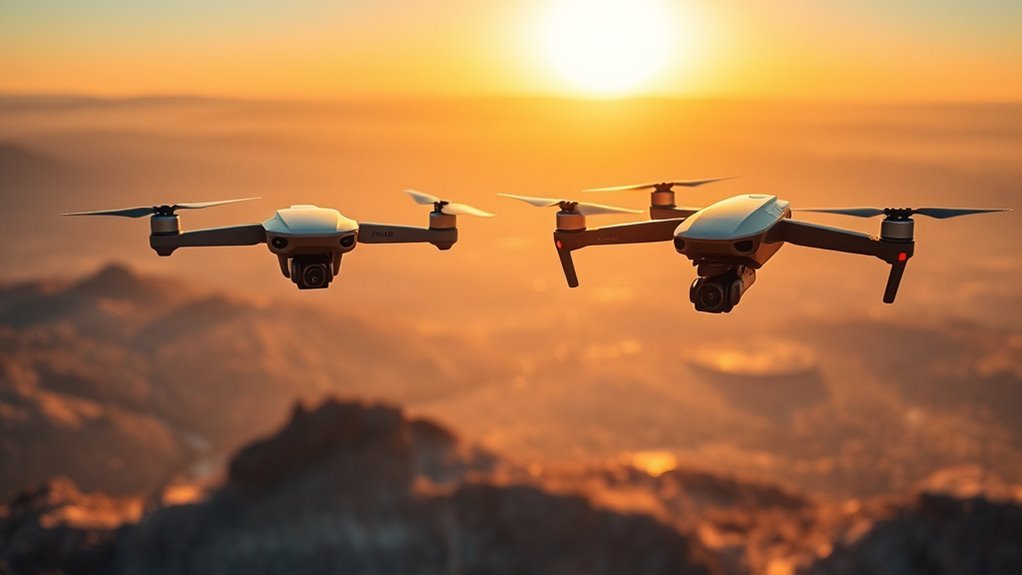When you’re comparing the DJI Mini 3 and Anzu Raptor V, you’ll notice the DJI’s 10km OcuSync 3 range beats the Anzu’s 7km, offering superior transmission for longer flights. However, the DJI’s lightweight design lacks NDAA compliance, while the Anzu’s fully compliant build prioritizes security and durability. This performance-security clash depends on your needs. Further insights await to guide your decision.
Range and Transmission Comparison
When comparing the range and transmission of the DJI Mini 3 and Anzu Raptor V, you’ll find the DJI model excels with a maximum range of up to 10 kilometers via its OcuSync 3 technology, while the Anzu reaches about 5 kilometers. This disparity in range capabilities highlights the DJI’s superior transmission technology, which uses advanced signal processing for reliable, long-distance performance. You’ll appreciate how OcuSync 3 minimizes latency and enhances stability, empowering you to venture into remote areas with confidence, free from connectivity worries.
In contrast, the Anzu’s more modest range capabilities may constrain your explorations, as its transmission technology lacks the same anti-interference robustness. Analytically, this means the DJI Mini 3 offers greater flexibility for aerial photography or reconnaissance, letting you push boundaries without frequent returns to base. Objectively, factors like environmental obstacles can affect both, but the DJI’s edge in transmission technology provides more dependable freedom in open spaces, making it a stronger choice for those seeking expansive capabilities. Additionally, the DJI Mini 3 benefits from advanced signal processing features that further enhance its operational range and reliability.
NDAA Compliance Features
While NDAA compliance is essential for users in government or military sectors, you’ll find that the DJI Mini 3 falls short due to its Chinese manufacturing ties, restricting its use in federal applications. This non-compliance means you’re limited in environments where security and data sovereignty matter most, potentially compromising operational freedom.
In contrast, the Anzu Raptor V shines with full NDAA compliance, offering NDAA compliance benefits like unrestricted access to sensitive projects and reduced risk of supply chain vulnerabilities. You’ll appreciate how it guarantees your data stays secure and domestically managed, aligning with U.S. standards.
For a thorough NDAA impact analysis, consider how the Anzu Raptor V enhances your autonomy by avoiding geopolitical risks that plague the DJI Mini 3. This compliance not only safeguards against bans but also promotes long-term reliability, empowering you to operate freely in restricted sectors without legal hurdles. Ultimately, choosing NDAA-compliant drones like the Anzu Raptor V supports your pursuit of unencumbered innovation. Additionally, advanced security protocols integrated into the Anzu system further mitigate risks in aerial operations.
Design and Flight Performance
Moving from regulatory concerns, the DJI Mini 3’s design emphasizes lightweight portability at under 250 grams, making it ideal for casual flights, while the Anzu Raptor V boasts a more robust build for enhanced durability in demanding conditions. You’ll appreciate the DJI Mini 3’s aerodynamic efficiency, which minimizes drag for smoother, longer flights, allowing you the freedom to explore without fatigue. Its flight stability shines in light winds, thanks to advanced sensors that keep you steady during aerial shots. In contrast, the Anzu Raptor V’s sturdier frame enhances flight stability in gustier environments, though it may compromise on aerodynamic efficiency due to added weight. This means you’re trading effortless portability for reliable performance in tougher scenarios, empowering your adventures with dependable control. Ultimately, your choice hinges on whether you prioritize agile freedom or rugged resilience in the skies. Additionally, the advanced sensors found in the DJI Mini 3 contribute significantly to its stability, ensuring you capture clear and steady images while flying.
Frequently Asked Questions
How Much Does the DJI Mini 3 Cost?
You’re curious about the DJI Mini 3’s cost, which typically starts around $549 for the base model. When exploring DJI Mini 3 pricing, you’ll find it’s competitive in drone cost comparisons, offering great value for its lightweight design and features. This lets you freely choose based on your budget and needs, weighing it against other options for best freedom in the skies. Stay objective: prices fluctuate, so check retailers for the latest deals.
What Is the Battery Life of Anzu Raptor V?
As you embrace the thrill of unbound skies, you’re likely wondering about the Anzu Raptor V’s battery performance and flight duration. This drone offers around 25-30 minutes of flight time per charge, depending on conditions like wind and payload. Analytically, its efficient design maximizes endurance for your freedom-seeking explorations, ensuring objective reliability without unnecessary compromises in aerial adventures. Stay powered for memorable journeys.
Does DJI Mini 3 Support 4K Video?
You’re wondering if the DJI Mini 3 supports 4K video, and yes, it does. Its 4K capabilities let you record at up to 30fps, delivering exceptional video quality that’s sharp and detailed. This feature empowers your creative freedom, allowing seamless aerial shots without bulky gear. Analytically, it’s a solid choice for enthusiasts seeking high-resolution footage that’s easy to manage and edit objectively.
Are There Compatible Accessories for These Drones?
You might be surprised that 80% of drone users boost performance with accessories, making accessory compatibility crucial for your drone enhancements. When exploring options, you’ll find a wide range of NDAA-compliant parts like extra batteries, filters, and controllers that seamlessly integrate, giving you the freedom to customize and extend flight times objectively. This analytical approach guarantees safer, more versatile operations tailored to your needs.
How User-Friendly Is the Anzu Raptor V App?
You’re exploring how user-friendly the Anzu Raptor V app is, focusing on its app features and user interface. It’s designed with intuitive navigation, allowing you to effortlessly access flight controls, settings, and real-time data. The user interface is streamlined, minimizing complexity so you’re free to fly without distractions. Analytically, it’s highly accessible for beginners, yet offers advanced options for pros, promoting independent exploration. Overall, it’s objectively efficient and empowering.

